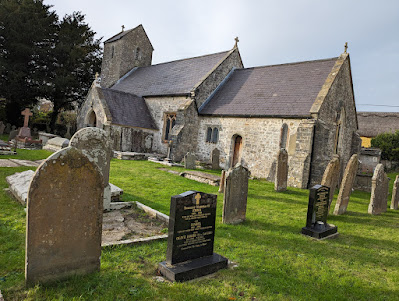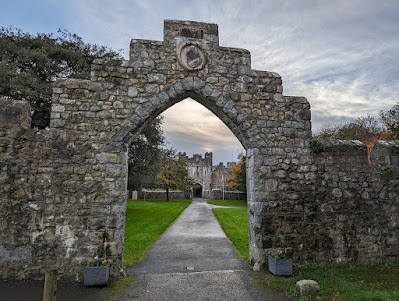A visit into the past: Day 4 - into the Valleys and the Vale
Glynneath
 |
| The new statue to Max Boyce |
The mural of Max Boyce happened to be on the side of a building that I was looking for - the Dinas Rock Inn - because it's marked on maps from the 1860s, when I think the young Mary Davies may have been living nearby.
 |
| The 'Dinas Rock Hotel' |
The 1861 census records a seven year old local girl, Mary Ann Davies, listed as a 'boarder/lodger', living in a shop run by 'grocer and draper, William Davies'. He was originally from the village of Llanddeusant, a village to the north of the Black Mountain that we had visited the day before (and there were certainly plenty of 'Davies' gravestones in its churchyard).
 |
| The churchyard in the village of 'Two Saints' |
Thanks to DNA and other census records, I have a hunch that this shopkeeper might be a cousin of Mary's father. The shop stood a little way down the main street from the Dinas Rock, at the top of 'Oddfellows Row'. Today's 'tanning and hair salon' at the top of today’s Oddfellows Street might be the same - or certainly a similar - spot.
 |
| Did my great grandmother live here? |
Nantymoel
Mary was my grandfather's mother but there was no father's name listed on his birth certificate. However, DNA matches suggest that the father might well have been Timothy Burke, part of an Irish family that had emigrated to South Wales from Kilbrittain in County Cork. In 1873, he married Mary Wallen, the daughter of another incoming family, this time from Somerset.
Census records show that the couple eventually settled at the top of the Ogmore valley, so we drove east from Glynneath to the top of the Rhondda Fawr valley, then, from Treorchy, up and over into the next valley at Nantymoel.
 |
| Looking back down into the Rhondda |
Timothy's death in 1915 is recorded as being at his home at 4, Park Street, Nantymoel. This proved to be, as I expected, not the most attractive street, in not the most attractive ex-mining town. However, on a sunny morning, the now tree-covered sides of the valley provided a pleasant backdrop.
 |
| The back gardens of Park Street |
On the way out of town we also drove past Aber Houses, the row of cottages where the couple are first recorded as living in the valley in the 1881 census.
 |
| Aberhouses |
Bridgend and the Vale of Glamorgan
Before moving to Nantymoel as a coal miner, Timothy had been living further south in the Bridgend area, where he had married Mary Wallen (and presumably also met Mary Powell). His father, William Burke, had lived his last years in the Bridgend and Cowbridge Union workhouse, which we found now converted into sheltered accommodation.
 |
| The Bridgend and Cowbridge Union workhouse |
William Burke's 1874 burial is recorded as being in the churchyard of nearby St.Mary's Coity but presumably in an unmarked pauper’s grave - we visited the church nevertheless.
 |
| St. Mary's, Coity |
From there, we drove through narrow lanes into the farmland of the Vale of Glamorgan, where it seems the Burkes had first lived after arriving from Ireland. Our first stop was Llandow, where the Burke family is recorded, as farm labourers, in the 1851 census.
 |
| Llandow |
There are still plenty of old village buildings standing around its old church, including an old thatched "church house" that may once have been the vicarage. We know from the census records that the Burke family were living in its vicinity.
 |
| 'Church House' |
But, best of all, as shown at the top of this post, we found a gravestone in the churchyard with the name of 'Thomas Burke', dying in 1915 at the age of 75. This is almost certainly the grave of Timothy's brother, baptised in Kilbrittain in May 1840!
 |
| The churchyard at Llandow |
This must also be the same Thomas Burke of Llandow who also turns up in a report in the 'Chronicle' about his trip to Bridgend !!
 |
| The Bridgend Chronicle |
Locals told us that there was still an old lady, Margaret Burke, living in the village but we decided not to try and find her, as the daylight was already drawing in and we still had a few more places to find. Instead, we drove on, a short way south of Llandow, to a partly flooded no through road that led over the modern railway.
I was looking for the farmstead of Sutton, where the 1861 census recorded Timothy Burke as working as a 'carter'. The road didn't look promising. However, not only was the farmstead there at its end, it still felt like the isolated old farm that must have been there long before even the Burkes.
 |
| Old farm buildings at Sutton, Llandow |
The main house looked ancient. It turns out to have originally been an Elizabethan Manor house first built as long ago as 1580.
 |
| Sutton Manor house |
From Sutton, we drove on to Llanbethery, another old village at the end of a lane, where Timothy is recorded as living as a farm labourer, this time in the 1871 census. Again a few old buildings could be found, and a 'VR' Victorian postbox is still set in the wall along the village street.
 |
| Llanbethery |
However, there were too many newer buildings in the village for it to retain the character of the other hamlets. The old pub, the 'Mason's Arms' in the time of the Burkes, had become a much restored house.
 |
| The much restored old pub |
Saint Donat's
Before we headed to Llanbethery, we had first driven to Llantwit Major, an old village overlooking the Bristol Channel which is named on my grandfather's birth certificate as his place of birth, in 1880.
But family lore had always been that his actual birthplace was a couple of miles further west, at St. Donat's Castle, whose grounds are now occupied by Atlantic College. Although of ancient origin, the castle had been much 'restored' by more modern owners including William Randolph Hearst (the original 'Citizen Kane').
 |
| St. Donat's Castle - now part of Atlantic College |
I'd visited the site before and remembered that, although you can only visit the castle as part of a pre-arranged tour, there was public access to the church underneath the castle walls. This is again of mediaeval origin but had been restored by another owner of the estate, John Whitlock Nicholl Carne, in 1878. This was also about the time that a 'Mary Powell' from Glynneath was a servant at the castle. This is very possibly the same "Mary Powell formerly Davies" that was my great grandmother.
 |
| The church below the castle at St. Donat's |
Memorials on the chancel floor 'honoured' Carne and his wife Mary Brancker. But how much 'honour' was there in a man who had grown rich from ownership of the Llanwonno coal seams and a wife whose Liverpool family had grown rich on slavery?
 |
| On the floor by the church altar |
 |
| A birthday meal in Cardiff to end the day! |





Comments
Post a Comment